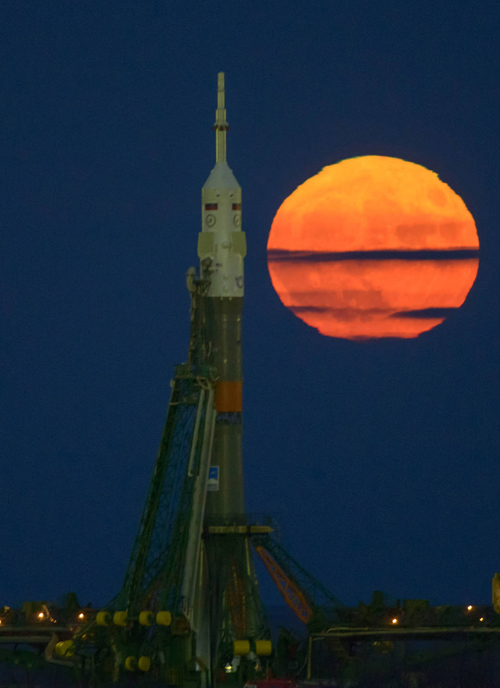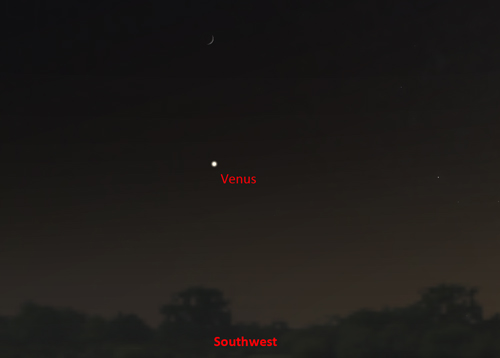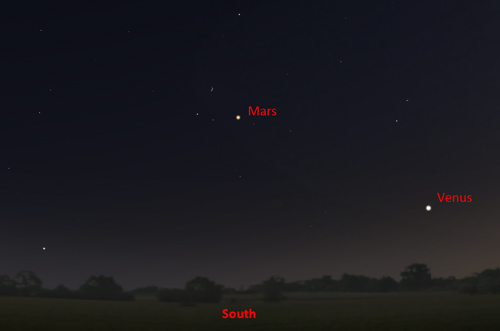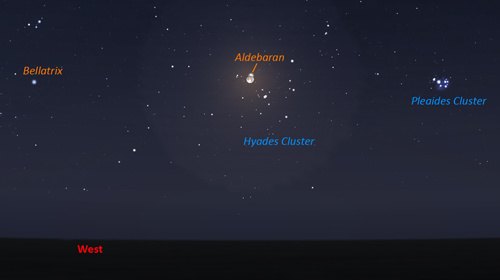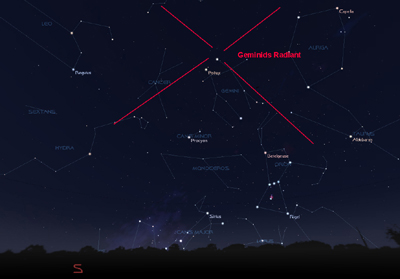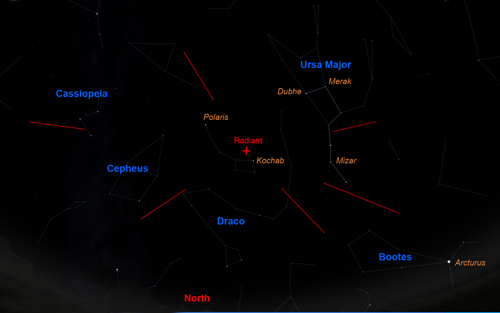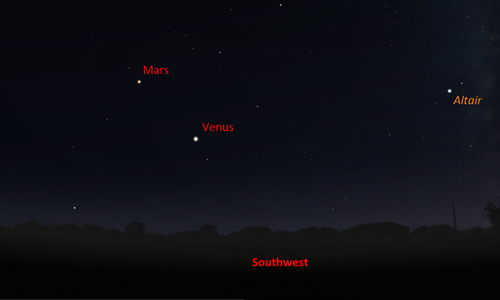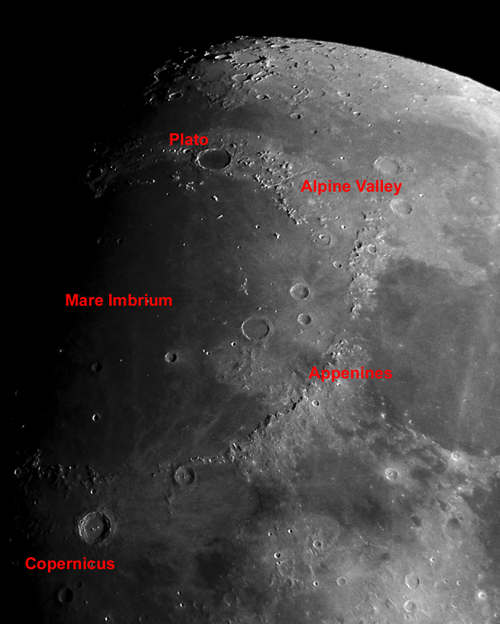The Stars
The Late Evening December Sky
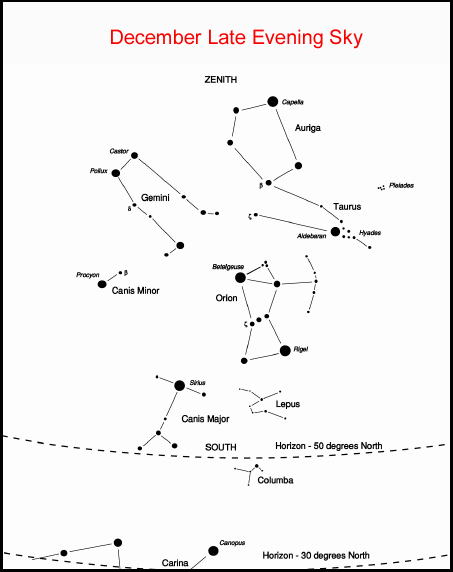 The December Sky in the south - late evening
The December Sky in the south - late evening
This maps shows the constellations seen towards the south in early and late evening. Setting towards the west in early evening is the beautiful region of the Milky Way containing both Cygnus and Lyra. Below is Aquilla. The three bright stars Deneb (in Cygnus), Vega (in Lyra) and Altair (in Aquila) make up the "Summer Triangle". East of Cygnus is the great square of Pegasus - adjacent to Andromeda in which lies M31, the Andromeda Nebula. To the north lies "w" shaped Cassiopeia and Perseus. The lower map shoesthe constellation Taurus, with its two lovely clusters, the Hyades and the Pleaides, and is also described in more detail below. as the evening draws on, Orion, the Hunter, follows Taurus into the eastern sky with the constellations Auriga, above, and Gemini, to the upper left. Later Sirius, in Canis Major will be seen to the lower left of Orion. Due to its brightness and scintillations caused by the atmosphere it often appears as a rainbow of colours flashing in the sky.
The constellations Pegasus and Andromeda
 Pegasus and Andromeda
Pegasus and Andromeda
Pegasus
The Square of Pegasus is in the south during the evening and forms the body of the winged horse. The square is marked by 4 stars of 2nd and 3rd magnitude, with the top left hand one actually forming part of the constellation Andromeda. The sides of the square are almost 15 degrees across, about the width of a clentched fist, but it contains few stars visibe to the naked eye. If you can see 5 then you know that the sky is both dark and transparent! Three stars drop down to the right of the bottom right hand corner of the square marked by Alpha Pegasi, Markab. A brighter star Epsilon Pegasi is then a little up to the right, at 2nd magnitude the brightest star in this part of the sky. A little further up and to the right is the Globular Cluster M15. It is just too faint to be seen with the naked eye, but binoculars show it clearly as a fuzzy patch of light just to the right of a 6th magnitude star.
Andromeda
The stars of Andromeda arc up and to the left of the top left star of the square, Sirra or Alpha Andromedae. The most dramatic object in this constellation is M31, the Andromeda Nebula. It is a great spiral galaxy, similar to, but somewhat larger than, our galaxy and lies about 2.5 million light years from us. It can be seen with the naked eye as a faint elliptical glow as long as the sky is reasonably clear and dark. Move up and to the left two stars from Sirra, these are Pi amd Mu Andromedae. Then move your view through a rightangle to the right of Mu by about one field of view of a pair of binoculars and you should be able to see it easily. M31 contains about twice as many stars as our own galaxy, the Milky Way, and together they are the two largest members of our own Local Group of about 3 dozen galaxies.
 M31 - The Andromeda Nebula
M31 - The Andromeda Nebula
M33 in Triangulum
If, using something like 8 by 40 binoculars, you have seen M31 as described above, it might well be worth searching for M33 in Triangulum. Triangulum is
the small faint constellation just below Andromeda. Start on M31, drop down to Mu Andromedae and keep on going in the same direction by the same distance as you have moved from M31 to Mu Andromedae. Under excellent seeing conditions (ie., very dark and clear skies) you should be able to see what looks like a little piece of tissue paper stuck on the sky or a faint cloud. It appears to have uniform brightness and shows no structure. The shape is irregular in outline - by no means oval in shape and covers an area about twice the size of the Moon. It is said that it is just visible to the unaided eye, so it the most distant object in the Universe that the eye can see. The distance is now thought to be 3.0 Million light years - just greater than that of M31.
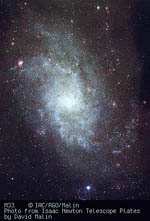 M33 in triangulum - David Malin
M33 in triangulum - David Malin
The constellation Taurus
 Taurus
Taurus
Taurus is one of the most beautiful constellations and you can almost imagine the Bull charging down to the left towards Orion. His face is delineated by the "V" shaped cluster of stars called the Hyades, his eye is the red giant star Aldebaran and the tips of his horns are shown by the stars beta and zeta Tauri. Although alpha Tauri, Aldebaran, appears to lie amongst the stars of the Hyades cluster it is, in fact, less than half their distance lying 68 light years away from us. It is around 40 times the diameter of our Sun and 100 times as bright.
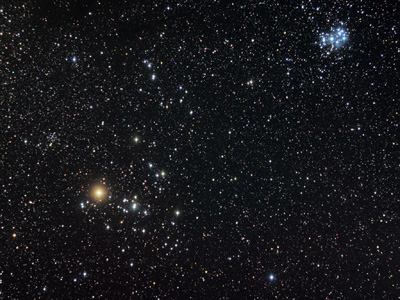 The Hyiades and Pleiades. Copyright: Alson Wong.
The Hyiades and Pleiades. Copyright: Alson Wong.
More beautiful images by Alson Wong : Astrophotography by Alson Wong
To the upper right of Taurus lies the open cluster, M45, the Pleiades. Often called the Seven Sisters, it is one of the brightest and closest open clusters. The Pleiades cluster lies at a distance of 400 light years and contains over 3000 stars. The cluster, which is about 13 light years across, is moving towards the star Betelgeuse in Orion. Surrounding the brightest stars are seen blue reflection nebulae caused by reflected light from many small carbon grains. These relfection nebulae look blue as the dust grains scatter blue light more efficiently than red. The grains form part of a molecular cloud through which the cluster is currently passing. (Or, to be more precise, did 400 years ago!)
 VLT image of the Crab Nebula
VLT image of the Crab Nebula
Close to the tip of the left hand horn lies the Crab Nebula, also called M1 as it is the first entry of Charles Messier's catalogue of nebulous objects. Lying 6500 light years from the Sun, it is the remains of a giant star that was seen to explode as a supernova in the year 1056. It may just be glimpsed with binoculars on a very clear dark night and a telescope will show it as a misty blur of light.
 Lord Rosse's drawing of M1
Lord Rosse's drawing of M1
Its name "The Crab Nebula" was given to it by the Third Earl of Rosse who observed it with the 72 inch reflector at Birr Castle in County Offaly in central Ireland. As shown in the drawing above, it appeared to him rather lile a spider crab. The 72 inch was the world's largest telelescope for many years. At the heart of the Crab Nebula is a neutron star, the result of the collapse of the original star's core. Although only around 20 km in diameter it weighs more than our Sun and is spinning 30 times a second. Its rotating magnetic field generate beams of light and radio waves which sweep across the sky. As a result, a radio telescope will pick up very regular pulses of radiation and the object is thus also known a Pulsar. Its pulses are monitored each day at Jodrell Bank with a 13m radio telescope.
The constellation Orion
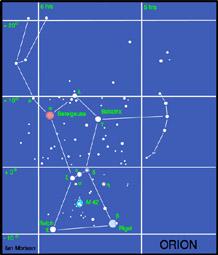 Orion
Orion
Orion, perhaps the most beautiful of constellations, will be seen in the south at around 11 - 12 pm during January. Orion is the hunter holding up a club and shield against the charge of Taurus, the Bull up and to his right. Alpha Orionis, or Betelgeuse, is a read supergiant star varying in size between three and four hundred times that of our Sun. The result is that its brightness varies somewhat. Beta Orionis, or Rigel, is a blue supergiant which, at around 1000 light years distance is about twice as far away as Betelgeuse. It has a 7th magnitude companion. The three stars of Orion's belt lie at a distance of around 1500 light years. Just below the lower left hand star lies a strip of nebulosity against which can be seen a pillar of dust in the shape of the chess-board knight. It is thus called the Horsehead Nebula. It shows up very well photographically but is exceedingly difficult to see visually - even with relativly large telescope.
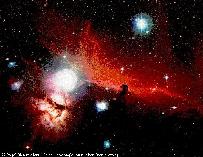 The Horsehead Nebula: Anglo Australian Observatory
The Horsehead Nebula: Anglo Australian Observatory
Beneath the central star of the belt lies Orion's sword containing one of the most beautiful sights in the heavens - The Orion Nebula. It is a region of star formation and the reddish colour seen in photographs comes from Hydrogen excited by ultraviolet emitted from the very hot young stars that make up the Trapesium which is at its heart. The nebula, cradling the trapesium stars, is a beautiful sight in binoculars or, better still, a telescope. To the eye it appears greenish, not red, as the eye is much more sensitive to the green light emitted by ionized oxygen than the reddish glow from the hydrogen atoms.
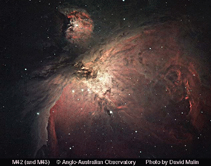 The Orion Nebula: David Malin
The Orion Nebula: David Malin
